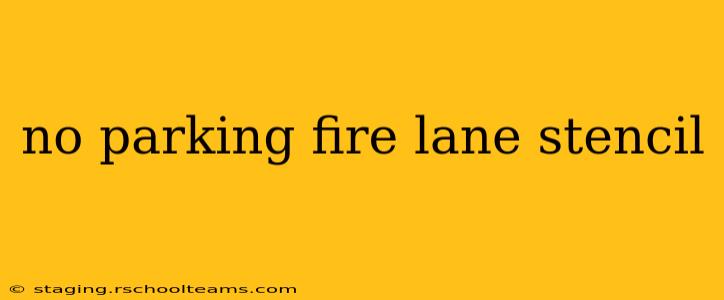Fire lanes are critical for emergency vehicle access, ensuring swift response times in emergencies. Obstructing a fire lane can have serious consequences, including hefty fines and potential legal repercussions. Clearly marking these areas with a "No Parking Fire Lane" stencil is essential for maintaining safety and compliance. This guide will delve into the specifics of fire lane stencils, covering everything from material choices to legal implications.
What is a Fire Lane Stencil?
A fire lane stencil is a reusable template used to create a highly visible "No Parking Fire Lane" marking on the ground. These stencils ensure consistent, professional-looking markings, unlike hand-painted options that can be uneven or fade quickly. They are typically made from durable materials designed to withstand heavy use and exposure to the elements. The stencils themselves are not the legal marking but the tool that creates it. The legal marking itself is usually done with paint.
What are the Different Types of Fire Lane Stencils?
Several materials are used to make fire lane stencils, each offering different benefits:
-
Plastic Stencils: These are common and relatively inexpensive. They're lightweight and easy to handle, making them suitable for smaller projects. However, they might not be as durable as other options, particularly under heavy use or extreme weather conditions.
-
Metal Stencils: Metal stencils, usually made from steel or aluminum, are significantly more durable than plastic. They can withstand more wear and tear and are ideal for frequent use or areas with high traffic. They are also more resistant to damage from chemicals found in paints and cleaners.
-
Reusable Stencils: Many fire lane stencils are designed for reuse. This is cost-effective as the stencil can be cleaned and used repeatedly for multiple applications.
What are the Legal Requirements for Fire Lane Markings?
Regulations surrounding fire lane markings vary by location (city, county, state). It's crucial to check with your local fire department or municipality to ensure compliance with all applicable laws. Generally, these regulations cover:
- Visibility: Markings must be highly visible, using bright colors (typically red) and clear lettering.
- Size: The size and font of the "No Parking Fire Lane" text must meet specific requirements.
- Placement: Markings must be strategically placed to clearly delineate the fire lane.
- Material: The paint used must be durable and weather-resistant, ensuring long-lasting visibility.
Failure to comply with these regulations can result in substantial fines and legal action.
What are the consequences of parking in a fire lane?
Parking in a fire lane is illegal and poses significant risks. Consequences can include:
- Fines: Fines for blocking a fire lane can be considerable and vary widely depending on location.
- Towing: Your vehicle may be towed at your expense.
- Legal Action: In some cases, more serious legal action may be taken, especially if your vehicle obstructs emergency access and results in injury or property damage.
Where can I find a fire lane stencil?
Fire lane stencils are available from various suppliers, including online retailers and specialty safety equipment stores. Look for stencils made from durable materials and ensure they meet local regulations regarding size and lettering.
How do I properly apply a fire lane stencil?
Proper stencil application is crucial for clear, long-lasting markings. This typically involves:
- Surface Preparation: Ensure the surface is clean, dry, and free of debris.
- Stencil Placement: Securely position the stencil using weights or tape.
- Paint Application: Apply the paint evenly, avoiding excessive amounts that may seep under the stencil.
- Removal: Carefully remove the stencil before the paint dries completely to prevent smudging.
By properly utilizing fire lane stencils and adhering to all regulations, you contribute to a safer environment for everyone. Remember to always prioritize safety and compliance when marking fire lanes.
